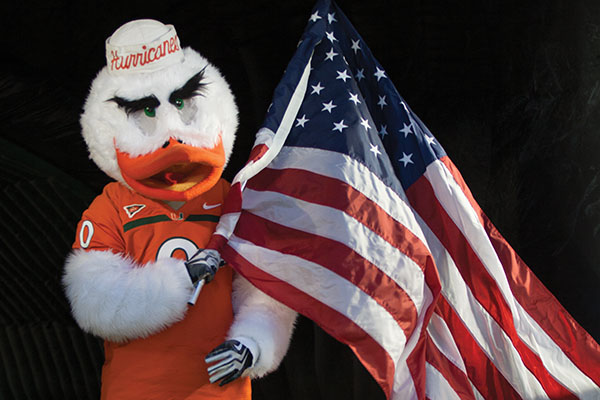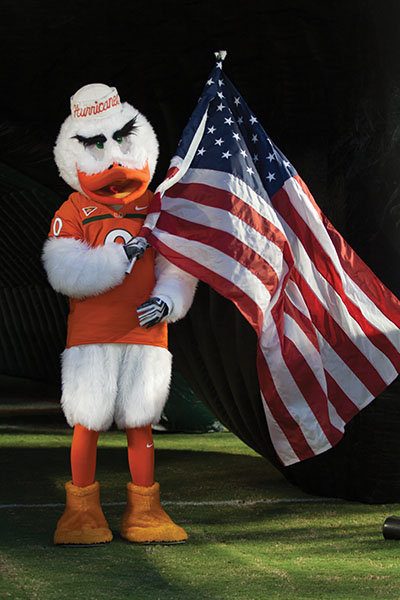Sebastian the Ibis, campus’s iconic aviary figure, is among 16 other mascots in the 2012 Capital One Mascot of the Year competition. Sebastian, one of three other ACC mascots in the competition, joins Testudo (University of Maryland) and Ms. Wuf (North Carolina State).
Voting for the title began Sept. 3, and will run through Nov. 26. The top eight mascots selected from the first round will then compete in a “bracket-style, single-elimination competition to determine the overall winner,” according to an article on hurricanesports.com. The winner will be announced on Jan. 1, 2013, and will receive a $20,000 scholarship to assist the school’s mascot program. According to the same article, each of the 2012 Capital One All-America team members will also receive $5,000 for their university mascot program.
The program dates back to the earlier days of the university.
During fall 1926, the first freshman class flocked to a fledgling University of Miami – a small campus that barely survived a major Category 4 hurricane a few days earlier.
Despite the school’s initial struggles, including mounting financial issues, UM survived.
Today, the school ranks among the leading private universities in the nation.
Throughout the school’s early years, the institution reorganized and underwent several redesign projects, in order to keep pace with its own city’s growth. In the face of constant change, however, the school transformed campus trends to traditions – including Sebastian the Ibis.
In 1926, the school’s yearbook dubbed itself the “Ibis.” The ibis, a local marsh bird native to south Florida and Egypt, became the school’s “unofficial mascot,” according to the university’s website.
According to hurricanesports.cstv.com, the athletic teams adopted the small white bird as their mascot in 1926.
“The University of Miami adopted the ibis as the official mascot for the university’s athletic teams, representing the leadership courage, knowledge, strength and speed characteristics that our student-athletes portray,” the article on that site said.
Tradition holds that the bird has an instinct to detect danger before other species – and, as such, “is the last sign of wildlife to take shelter before a hurricane hits, giving warning that danger is imminent.”
After a storm, the ibis is typically the first wildlife to reappear.
This small, 2-foot-tall bird’s popularity soared at UM in the 1950s.
In 1955, the first Student Activities Director Norman Whitten, after whom the University Center is named today, created Sebastian.
“Norm Whitten was a very charismatic individual and everybody loved him,” Allan Herbert told The Miami Hurricane in 2005. “The students loved him and he was a terrific person. Norman was a 100-percent Miami Hurricane, and the bird he created was his personality.”
According to UM’s website, “In 1957, San Sebastian Hall, a residence hall on campus, sponsored an ibis entry into the Homecoming celebration.”
The ibis was named Sebastian, after the residence hall where the tradition began.
The next year, student John Stormont donned a “glued, sewn and pinned loosely” ibis costume at several games. Though Sebastian’s feathers have been revamped several times, Stormont’s initial appearances started the tradition.
However, 1950s Sebastian was not the mascot of today. Rather than throwing up the “U,” he sported a corncob pipe and a sailor hat with an “M” on the front in his early days.
In the 1960s, papier-mache and tights were the costume’s main ingredients. Around the same time, UM had two mascots, a male ibis and a female ibis. A female, however, has not played Sebastian in recent years. A decade later, Walt Disney World redesigned the ibis costume four times.
Today, a woman hand makes the costumes from her home. Each mascot receives an individualized costume, and is responsible for maintaining it clean. The “body” can go in the washer, but the head must be cleaned by hand.
In October 2005, Sebastian the Ibis celebrated his 55th anniversary – making the mascot a near 62-year-old senior citizen.
Despite the tradition’s age, Sebastian and his popularity is far from outdated. Students can only don the Sebastian attire provided they perform well in tryouts held at the beginning of each school year.
According to the faculty member formerly in charge of the program, the position does not require students have a specific height or weight. They do, however, “have to look great in the costume.” They are also required to be excellent 3-point shooters, for the purpose of their appearance in basketball games, and must be able to perfectly do the C-A-N-E-S spell out.
Today, Sebastian is required to make appearances approximately 300 times during the school year – and that’s not including sporting events. At sporting events, Sebastian entertains the crowd. He also makes appearances at community events and personal celebrations.
The faculty member wishes to remain unnamed because she is no longer the head of the program.
Tryouts for the mascot position are extremely confidential. They are also held at an anonymous location, and hopefuls must fill out an extensive application.
“This whole thing has to be kept secret because that’s the nature of the mascot,” said a source whose identity cannot be disclosed, in an interview with The Miami Hurricane in 1996. “It ruins the image when people know who’s behind the costume.”
Since 2009, however, the close-knit group of students who wear the costume started a tradition: At graduation, the Sebastians can disclose their identity as the mascot by wearing the tights and shoes beneath their gowns.
“I got a couple of texts from kids I’d known,” said Mathew Scholtec, who graduated from UM in 2011 and wore the costume for four years. “They thought it was pretty cool.”
While he admits the heavy, heat-attracting costume made football games the worst part of the experience, he also acknowledged the prestige and honor associated with UM’s mascot.
“The perk of just being Sebastian, I think that’s the best,” he said. “You get to travel to cool places, meet a lot of cool people, and being on the football field is pretty awesome.”
The position is unpaid, despite its demanding schedule. Students, however, can disclose their identity to their relatives and place their experience as the school mascot on their resumes.
Tryouts are held according to the number of students needed to fill vacant spots after graduation.
Sebastian hopefuls can try out in the fall. For more information, contact the athletic department.
Fans can vote for Sebastian at CapitalOneBowl.com, on Facebook.com/Mascot Challenge or on Twitter, @Capital1Mascot.







